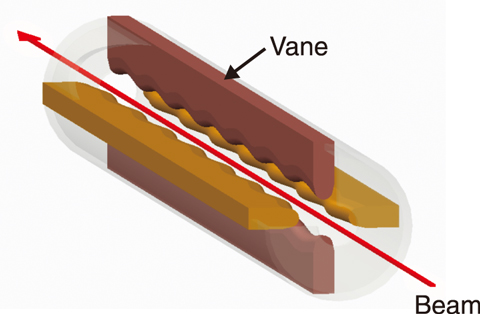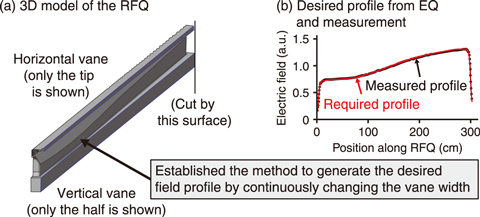
Fig.5-2 Schematic view of the RFQ

Fig.5-3 3D design method to obtain the desired field from the equipartitioning

Fig.5-4 Beam test of the new RFQ
The radio frequency quadrupole linac (RFQ) is the frontend accelerator of the J-PARC accelerator complex. It is a critical accelerator which determines the beam quality. We realized a new dynamics RFQ implemented a beam dynamics scheme optimized for the high-intensity beam.
To accelerate low-energy particles effectively, the RFQ uses the electric field generated by the four vanes surrounding the beam, as shown in Fig.5-2. To satisfy the requirement of J-PARC, a 60-mA beam should be accelerated. At this high current, the repulsive force between each particle in the beam (space-charge force) is very strong; how to overcome this force is a large issue.
We focused on the equipartitioning (EQ) scheme which is the de facto standard for the linacs except for the RFQ. This scheme is suitable for accelerating high-intensity beams because it properly treats the space-charge force and balances the focusing and accelerating forces. However, in the RFQ, both the focusing and accelerating force should be generated by the shape of the vane-tips, different from the ordinary linacs, in which both the forces can be adjusted independently. Consequently, a more-complex electric field profile than the ordinary RFQ is required if the ideal EQ is adopted. To avoid this difficulty, we partially applied the EQ to only the most important part for the beam dynamics. This makes the field profile flat. This RFQ is providing the beam every day for the user operation of J-PARC.
Toward the improvement of the performance of the RFQ, we progressed the development based on the experiences of the current RFQ. We performed more detailed beam simulation, and newly developed a method to obtain the required electric field from the equipartitioning with full use of the three-dimensional electromagnetic design tool, as shown in Fig.5-3. With these efforts, we succeeded in developing the world first fully equipartitioned RFQ used for user operation which requires high reliability. As shown in Fig.5-4, the beam test was conducted and the required beam performance was achieved. From this result, we proved that the required performance for J-PARC can be realized with the compact RFQ whose length is 15% shorter by optimizing the beam dynamics.
Since this beam dynamics design scheme contributes to the cost reduction, it is expected not only to be used for the large-scale facilities like J-PARC but also to meet the increasing demands for wider applications such as compact neutron sources.
(Yasuhiro Kondo)
<Previous: 5 Applied Neutron and Synchrotron Radiation Research and Development | Next: 5-2>